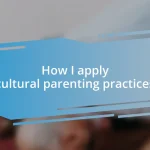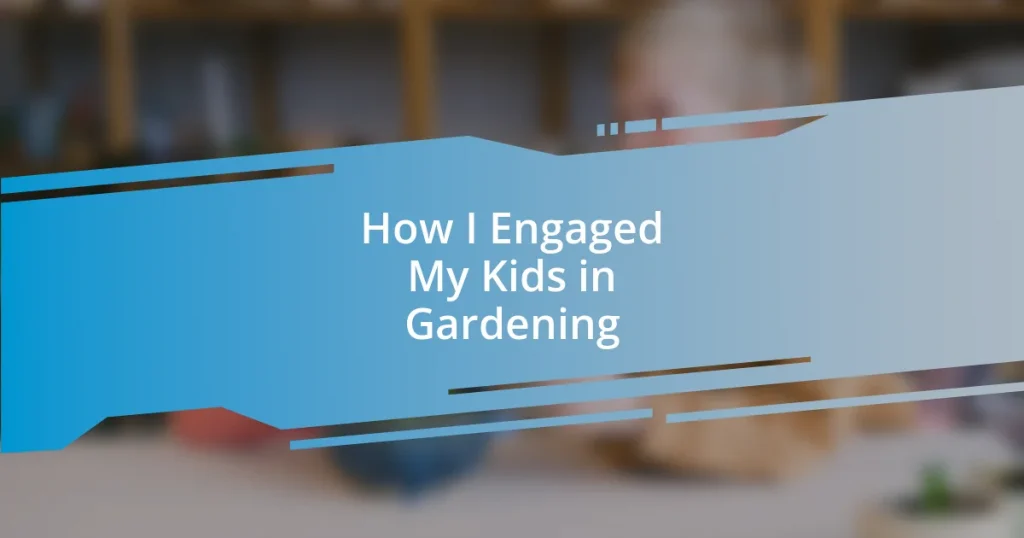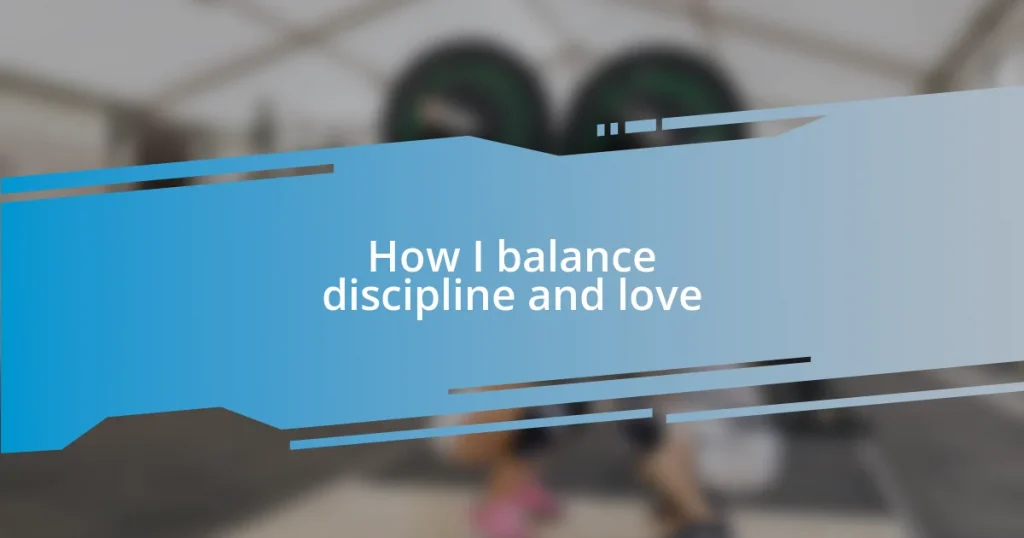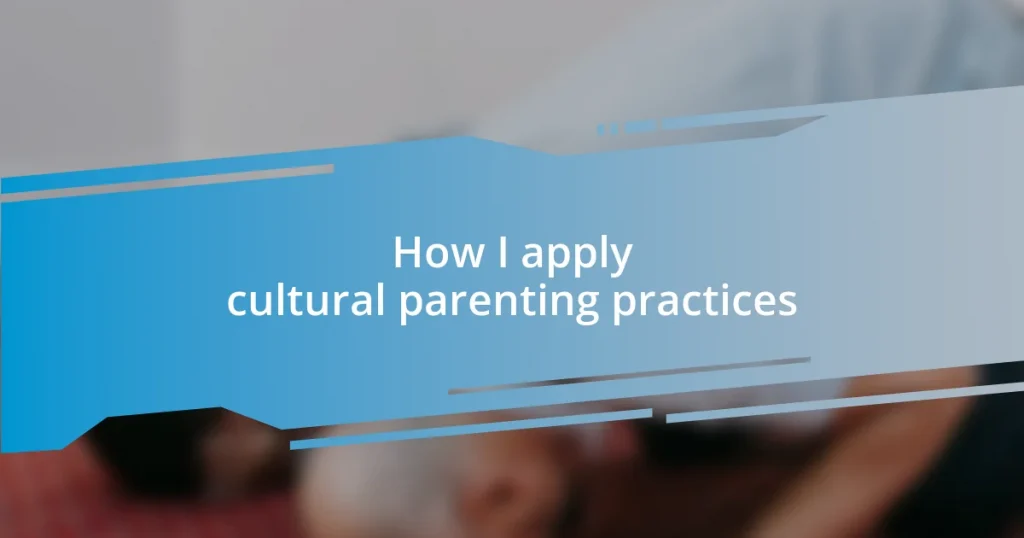Key takeaways:
- Gardening fosters curiosity, emotional well-being, and teaches responsibility and patience in children.
- Choosing the right plants and creating a kid-friendly garden encourages engagement and investment in the gardening process.
- Celebrating gardening achievements nurtures confidence, promotes teamwork, and provides teaching moments about resilience and growth.
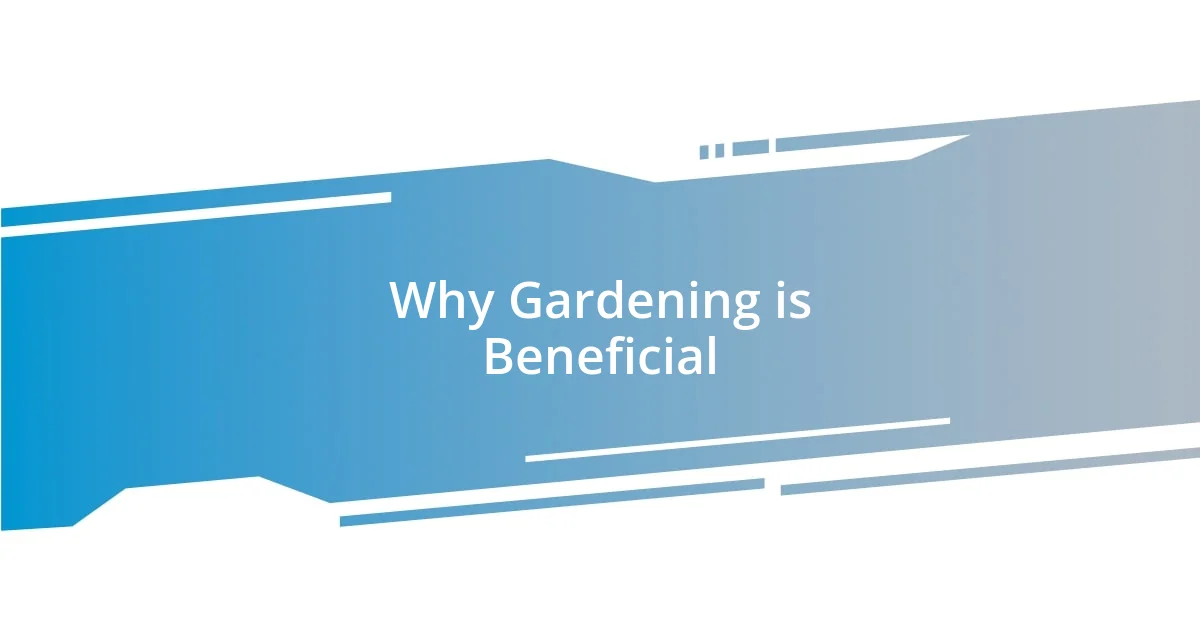
Why Gardening is Beneficial
Gardening offers incredible benefits that extend far beyond the beauty of blooming flowers. I remember the first time my kids got their hands in the soil, their faces lit with excitement as they discovered tiny worms wriggling through the dirt. That moment was not just about planting seeds; it sparked a curiosity about nature that I never anticipated. How often do we have the chance to witness that kind of wonder?
Moreover, gardening is therapeutic. The simple act of digging, planting, and watering can relieve stress and promote emotional well-being. I found myself unwinding after a long day, feeling rejuvenated while listening to the rustle of leaves and birdsong. Have you ever felt that calming effect of being connected to nature? I’ve seen my kids mirror this calmness, turning a challenging day into laughter and joy as we worked together outside.
Finally, one of the most significant advantages is the wonderful lessons it imparts about responsibility and patience. I usually initiate a small family project, like growing cherry tomatoes, and watching them tend to the plants teaches them the value of nurturing. What could be more rewarding than the moment they pick their first ripe tomato, realizing their hard work has paid off? It’s a delightful blend of effort and reward that fuels their pride and enthusiasm for gardening.

Choosing the Right Plants
Choosing the right plants can be a pivotal moment in any gardening project with kids. I remember when my daughter chose sunflowers for our first garden; their towering stature and vibrant yellow petals made her eyes sparkle with anticipation. Not only are sunflowers easy to grow and maintain, but they also attract pollinators, which sparked a lively discussion about bees and butterflies. Have you ever noticed how certain plants can ignite a child’s interest in the world around them?
It’s also essential to consider the climate and the growing conditions of your garden. When we decided to plant herbs, I explained to my kids how basil thrives in warm sunlight while mint prefers some shade. This led us to devise unique little spots around our garden where each plant would flourish best. By allowing them to select plants based on their preferences for sun and water, they became invested in the process, showcasing their chosen herbs in a mini garden of their own.
Lastly, choosing plants with varying lifecycles can keep the gardening experience fresh and exciting. For instance, we planted quick-growing radishes alongside slower-growing carrots. I loved the way my son’s impatience for the radishes turned into excitement when we finally pulled them out of the ground. Watching them evolve over time reinforced the idea that every plant, much like each child, has its own timeline and journey to follow.
| Plant Type | Characteristics |
|---|---|
| Sunflowers | Easy to grow, attracts pollinators, quick growth |
| Basil | Thrives in sunlight, fragrant, commonly used in cooking |
| Mint | Prefers shade, spreads quickly, refreshing taste |
| Radishes | Fast-growing, vibrant colors, can be harvested quickly |
| Carrots | Slow-growing, underground, patience required to harvest |
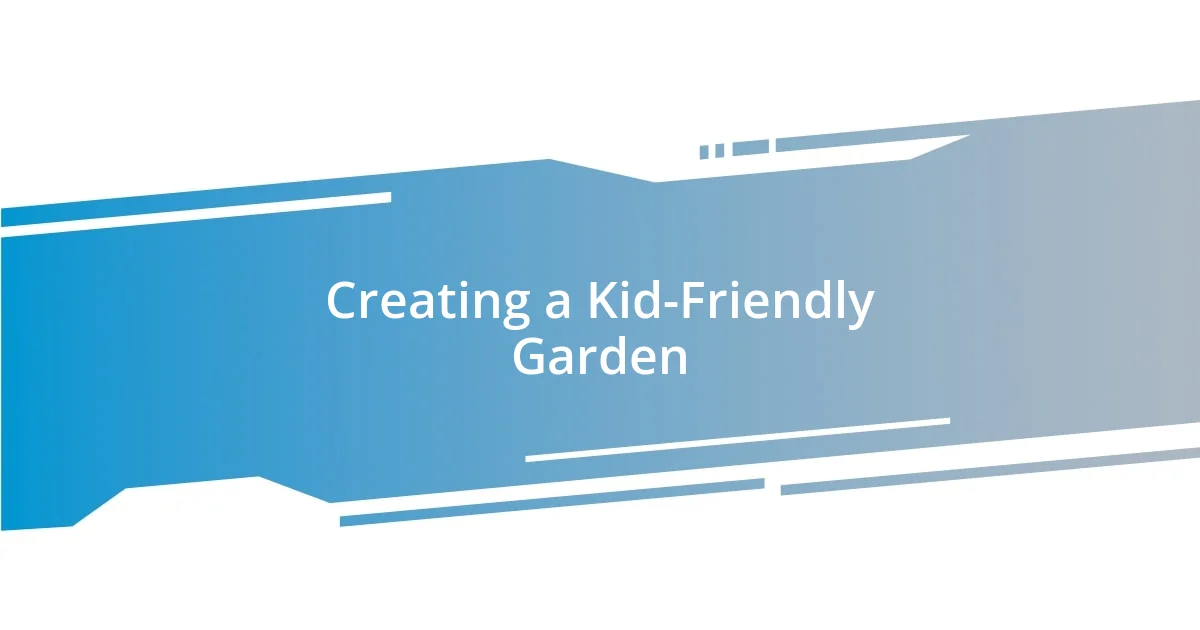
Creating a Kid-Friendly Garden
Creating a kid-friendly garden is all about making the space inviting and enjoyable for little hands and curious minds. I vividly recall the first time we established a small plot in our backyard, surrounding it with colorful markers that identified each plant. Watching my children enthusiastically paint rocks to label their mini garden was a heartwarming sight. It transformed our gardening area into a vibrant learning hub where they could proudly display their handiwork.
Here are some key features to consider when designing a garden that kids will love:
- Raised Beds: These are easier for little ones to reach and maintain, keeping them engaged without the frustration of bending down.
- Sensory Elements: Incorporate plants with different textures, scents, and colors. Herbs like lavender and mint can be particularly stimulating.
- Paths for Exploration: Create winding paths with mulch or stones that invite exploration. It turns gardening into an adventure!
- Kid-Sized Tools: Provide small, lightweight gardening tools to empower them to participate fully in planting and caring for the garden.
- Seating Area: Add a cozy spot with a small bench or a few cushions where kids can take a break and observe their plants growing.
Setting the stage for a kid-friendly garden not only enhances the experience but also fosters a deeper connection with nature for children. The joy I see on my kids’ faces as they run to check for new sprouts or pick their first flowers makes all the effort worthwhile. Each garden visit becomes a new chapter in our ongoing exploration together.
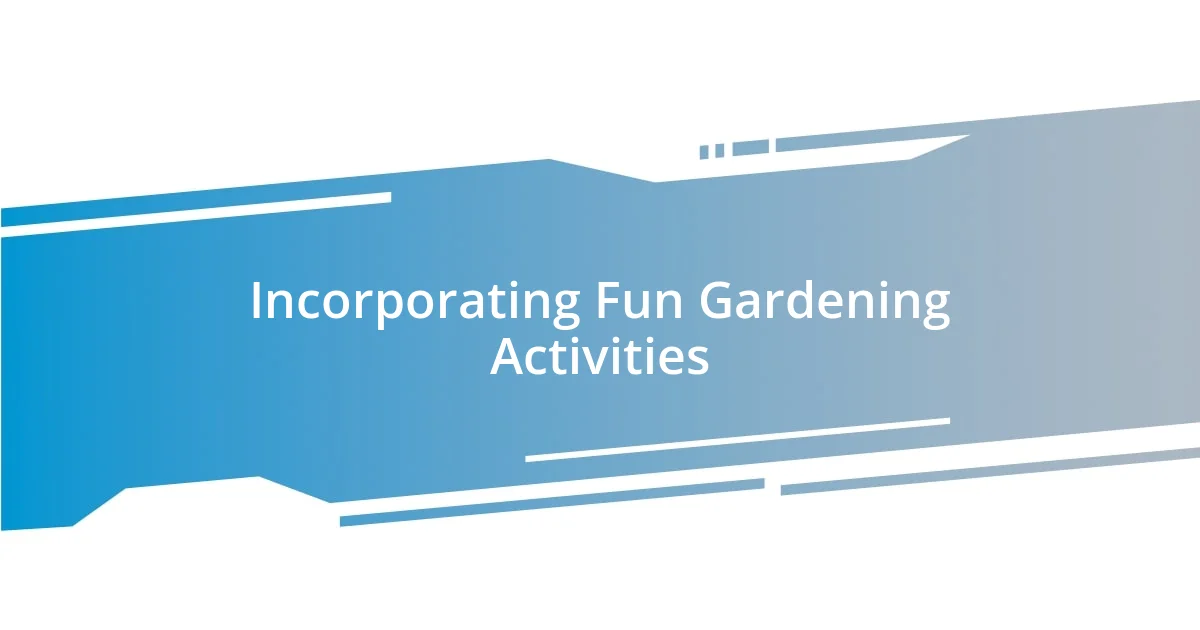
Incorporating Fun Gardening Activities
Incorporating fun gardening activities is where the magic truly happens. One day, I turned weeding into a game by timing my kids to see who could pull the most weeds in ten minutes. Their laughter filled the garden as they raced against the clock, completely forgetting about the chore aspect. It was fascinating to see how a little competition could transform what might seem like a dull task into a vibrant, energetic experience!
Another memorable moment came during our “garden treasure hunt.” I hid small toys and seeds around the garden, giving my kids clues about where to find them. As they searched, they became more engaged with the space, noticing details they hadn’t seen before. This adventure sparked their curiosity, and they began asking questions about each item they uncovered. Have you ever noticed how the simple act of searching can ignite a child’s sense of wonder?
Lastly, I introduced “flower art” day, where we harvested petals and leaves to create stunning collages. Watching my children squeeze their fingers into the clay and gently arrange each piece made my heart swell with pride. The way they described their creations—the “dancing daisies” or the “sunset roses”—brought into focus how gardening can intertwine creativity with nature. What activities have you found that blend fun and learning in your own gardening experience?

Teaching Kids About Nature
I’ve always believed that teaching kids about nature starts with immersing them in the wonders around them. One afternoon, I took my kids on a “nature walk,” guiding them to collect interesting leaves, rocks, and flowers. As we picked up these treasures, I asked them to identify their favorite colors or textures. It was heartwarming to see their eyes light up at the diversity of nature, transforming a simple walk into an explosion of discovery. Have you noticed how curious kids can be when they encounter new scents or sights?
Observing my children as they examined a ladybug crawling on a leaf was a pivotal moment for me. They were fascinated, asking questions like “What does it eat?” and “Where does it live?” I encouraged them to find answers, which sparked an exploration of ecosystems right in our backyard. This experience not only taught them about ladybugs but opened up discussions about the interconnectedness of all living things. It was a beautiful reminder of how curiosity can lead to invaluable lessons about biodiversity.
During one gardening session, I introduced my kids to the idea of “garden friends and foes.” We talked about beneficial insects versus pests, and they eagerly began to spot ladybugs—our allies—and aphids—our foes. Watching them proudly defend their plants from “bad bugs” made me realize the lasting impact this lesson would have. Have you seen how empowering it can be for kids when they feel in charge of nature? It’s about fostering respect for the environment while teaching them responsibility and stewardship at a young age.

Maintaining the Garden Together
Maintaining our garden together has become a shared adventure that fosters teamwork. I remember the first time my kids and I tackled our garden’s overgrown patches; we laughed our way through the chaos, jokingly dubbing ourselves the “Garden Avengers.” Each task felt less like work and more like a mission, turning routine upkeep into a fun and collaborative experience.
One Saturday morning, I handed them each a watering can, and we took turns doing the rounds. As they joyfully splashed water on the plants, we started a playful conversation about giving our plants a drink. I asked, “What do you think they feel when we water them?” Their imaginative responses, filled with personality traits for the flowers, showcased how engaged they were in the process. It was a heartwarming realization; even routine tasks can open doors to deeper connections and understanding.
Recently, we created a “garden journal” to track our daily maintenance activities. In the afternoons, we’d gather to jot down what we’ve done—the plants we’ve watered, the weeds we’ve pulled, and the colorful blooms that emerged. It became a cherished tradition, and I found that reflecting on our progress was just as uplifting as the gardening itself. Have you ever noticed how documenting a journey makes you appreciate it even more? It instilled a sense of ownership and pride, reminding us all how much we grow—not just in our garden, but together as a family.

Celebrating Gardening Achievements
Celebrating the little victories in our gardening journey has become a cherished ritual in our household. After harvesting our first batch of tomatoes, we gathered around the kitchen table, beaming with pride. I asked my kids, “What does it feel like to eat something you’ve grown?” Their smiles said it all; they felt a sense of accomplishment that went beyond just enjoying a meal. It’s incredible how sharing a simple moment like this can cultivate confidence in children, reinforcing the idea that their efforts yield tangible results.
I remember when my youngest successfully planted her very first flower. The excitement was palpable, and we didn’t just acknowledge it with words. We threw a mini “flower party” in our garden, complete with silly hats and homemade snacks. Everyone joined in, marveling at her efforts and creativity. By celebrating these achievements, I noticed their enthusiasm for gardening grew, transforming it into a joyful family bonding experience. Have you ever considered how a little celebration can amplify a child’s motivation to try new things?
These celebrations have also become teaching moments, where we discuss what worked well and what didn’t. After a successful gardening season, we reflect on the lessons learned, like how certain plants thrived while others didn’t. I’ll often say, “Failures are just steps toward success,” which has resonated with my kids. It’s a reminder that each setback is a valuable lesson in resilience and growth. Being together through these ups and downs nurtures not just their love for gardening but also a lifelong appreciation for the learning process itself.



